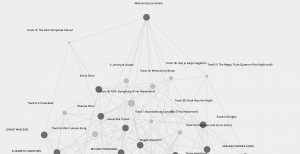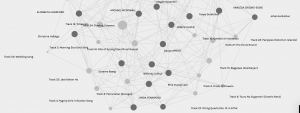

I posted this image to show my name on top stretching the matrix so I could see where my nodes and edges connected. While looking at the image, re-playing the songs and looking at the connections this matrix is all about the human experience. Each of us had the task to encapsulate what is the human experience, what is our identity? Music is universal, it connects people, it is part of our experience. We all have songs that are attached to amazing memories and songs to times we wish we could forget. If looking at the graph properly this experience has songs that epitomize humans, the good, the fun and yes the flaws too. These digital files now give the opportunity for the human experience to be shared with other life forms. As I discussed in post 8, Smith (1999) states, “Digital files can provide extraordinary access to information. They can make the remote accessible and the hard to see visible. Digital surrogates can bring together research materials that are widely scattered about the globe, allowing viewers to conflate collections and compare items that can be examined side by side solely by virtue of digital representation.” There is a digital footprint to share the experience of culture and diversity from different parts of the globe. In summary the algorithm represents the human experience and all the emotions that make us the beings we are, the good, the bad and the ugly.
Reference:
https://hdlab.stanford.edu/palladio-app/#/visualization
Smith, A. (1999). Why digitize? Retrieved June 15, 2019, from Council on Library and Information Resources website: https://www.clir.org/pubs/reports/pub80-smith/pub80-2/